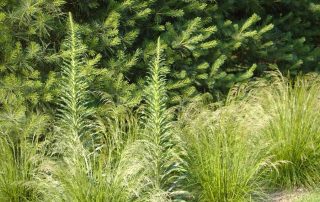Deschampsia Meadow
The Deschampsia Meadow is so named due to the predominance of the Deschampsia ceospitosa cultivar ‘Bronzeschlier’. Here, this native grass is used to create a naturalistic type of planting called a matrix planting, a relative minority of flowering plants interspersed within a visually dominant matrix of grass. The resultant dreamy meadow-like atmosphere creates a sense of wholeness and fully encompasses the immediate nursery sales area with its mass. Its soft, cloud-like inflorescence is juxtaposed and accentuated by the hard, flat, and linear brick paving, stone pathway, ranks of potted plants, and the Perennial Meadow, which is a more diverse and colorful planting. Within the planting itself, the structure of the forbs provides a strong contrast with their emergent, upright, and long-lasting forms. What is of particular interest here is the harmonious co-evolution of the grass and forbs with visual continuity that remains effective over a long period – from spring to winter. Just before winter, the clumps of Deschampsia are finally clipped into their final topiary-like form. It is then that the individual plants are more evident, creating a sense of formality with their ranked orderliness.
From a cultural standpoint, clipping the Deschampsia foliage is necessary to reduce the amount of damage wrought by invading critters who relish the abundance of nest-building material, stockpiling it in the homes they have built within the root system of the grass itself. Leaving a planting of any type intact and through the winter increases the likelihood of it becoming a metropolis for rodents, though cutting it back the final expression of the garden is lost. As the grass is clipped, its leaves fall naturally around its base, creating an excellent moisture-retaining, weed-suppressing, soil-building mulch. As the individual plants senesce, they leave behind improved growing conditions for their replacements.





















































